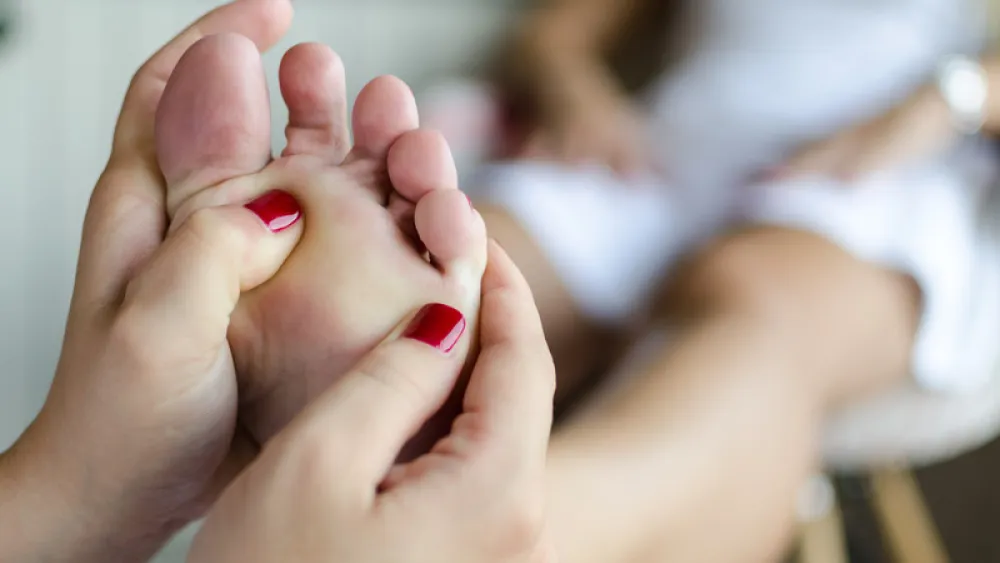




Today's Medicine
Feet, Don't Fail Me Now


The struggle is real
Many of my older patients struggle with foot pain. And it’s no wonder why.
Through the years our feet have chased after children and grandchildren, walked school and hospital hallways, exercised our bodies, and helped us stand tall in our finest hour. But as the years go by, we experience changes to the 26 bones, 33 joints and more than 120 muscles, ligaments, tendons, and nerves in our feet. And sometimes those changes can mean pain. In fact, one in three people over the age of 65 have foot pain, stiffness or aching feet.
Common complaints
We used to think foot problems were caused by improper or poor fitting shoes, but that is rarely the case. In most cases, it's either regular wear and tear or genetic.
Here are the seven common age-related foot complaints I see in my patients—and how you can give them the boot:
- Arthritis. Easily the number one complaint among my patients suffering from foot pain, arthritis causes inflammation and stiffness in the joints. It comes as a consequence of years of wear and use. There are more than 100 different types of arthritis, and controlling the pain can come in many different forms, from anti-inflammatory medications to ice packs or injections.
- Bunions. As many as a third of all older people have a bunion. Bunions happen when the first toe of the foot starts to shift toward the second toe, causing a large bump or prominence on the inside of the foot. They can hurt a lot if those bones start to rub inside shoes. Sometimes the big toe can also rub on the second toe, causing it pain or problems. Some patients find some relief by modifying their shoes with padding, but that won’t correct the underlying deformity. You will need an operation to realign the bones so they are straight. Typical recovery for that surgery takes about two months.
- Hammer Toes. Hammer toes are caused by a tendon imbalance in the foot which can happen as people age. That imbalance will cause the toes to curl up and flex down, making it look like a claw. This deformity causes a bump on the top of the foot which can painfully rub on shoes and adjacent toes. Once the deformity has formed, it will not go away on its own. In-shoe padding, braces or even special shoes can help relieve that pressure and rubbing, but the problem can only be fixed with surgery.
- Flat Feet. Although flat feet can be genetic, they are often caused by an injury to the tendon which supports the arch called the posterior tibial tendon. If that tendon is injured or damaged, it can no longer support your arch and over time that arch can start to flatten and cause pain. Arch supports can help, as can physical therapy. If you notice your arch starting to flatten, physical therapy can help support and strengthen that tendon. Most of the time conservative measures will work well with flat feet. If my patients have a lot of pain, we can also consider injections or immobilizing the foot with a special cast or boot. If those don’t work, surgery is the next option.
- Tendonitis. Tendonitis comes in many forms. There are dozens of tendons and ligaments holding your foot together, and tendonitis is a catch-all phrase for injury or pain associated with any one of them. Ice, anti-inflammatory medications, immobilization and physical therapy are all options for treatment. Different tendons are all treated differently, so therapy is based on what tendon is causing the problems.
- Fat Loss. Most people aren’t going to complain about losing a little fat, but feet are the last place where you want to lose it. Fat provides the built-in insoles on the bottom of your feet, creating a cushion for every step you take. As we age, that fat tends to slowly disappear, putting more pressure on the bones and joints in your feet, causing problems with overload, pain and neuromas. Insoles and modifying your shoes can greatly help, but unfortunately, there's nothing you can do to prevent the loss of padding.
- Neuropathy. This disease is most commonly found among diabetics, but it can strike non-diabetics as well. Neuropathy affects the small nerves of the feet, causing numbness and decreased feeling. Unfortunately, the pain can be quite severe, feeling like you are stepping on tiny pins. There is no cure for neuropathy, but some oral and topical medications can make people feel better. Those medications are really only given to those with pain. Numbness brought on by neuropathy cannot be reversed by medication, and there is no cure.
Prevention is key
Older people are more likely to have foot pain if they also have a chronic disease. If you have diabetes, foot health is of the utmost importance. Even seemingly minor foot problems can pose serious threats to your health.
Foot health is oftentimes directly related to checking your feet on a daily basis. If you start to notice there are problems, talk with your Methodist Physicians Clinic primary care provider, or see an orthopedic surgeon who specializes in feet and ankles.


